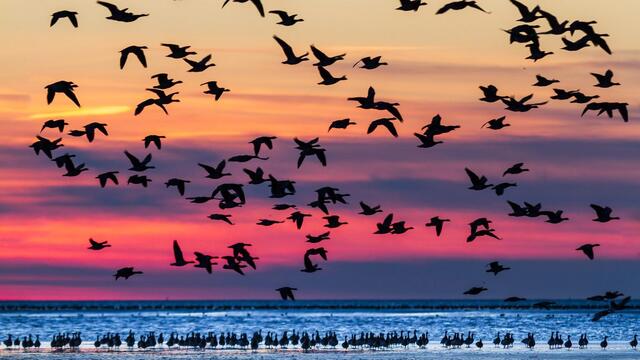
West Coast Vogelkiek in Schleswig-Holstein
National Park Wadden Sea Schleswig-Holstein (D)
Read more
Since 1978, Denmark, Germany and the Netherlands have been cooperating to ensure transboundary protection and management of the Wadden Sea as a shared natural entity. Almost the entire Wadden Sea is protected by national parks and nature reserves.
Many of the 140 fish species recorded in the Wadden Sea are visiting from the North Sea. Others use the Wadden Sea as a passage during their migration from the sea to the rivers, as an important nursery area for juveniles or as a spawning area in the North Sea. About 20 species are resident in the Wadden Sea and leave the tidal area only during exceptionally cold winters.
Around 3.75 million people live on the mainland along the Wadden Sea. A further 75,000 people live on the islands.
A regular census of 31 breeding bird species found 469,000 breeding pairs. This indicates favourable food availability and natural breeding success. Six species have over 25 % of their north-western European population breeding in the Wadden Sea.
Salt marshes are hot spots of flora, fauna and biodiversity in the Wadden Sea. They host an incredible richness of insects and spiders, which are dependent on the specific salt marsh vegetation.
were counted in summer 2024 on the sandbanks of the Wadden Sea – a steadily increasing number of harbour seals since the first Wadden Sea-wide seal counts in 1975. The total population is estimated to 34,900 individuals.
The Wadden Sea demonstrates high faunal diversity compared to other coastal wetlands, with over 10,000 species found. The availability of food and the low level of disturbance are essential factors supporting survival of migratory species. Global biodiversity is reliant on the Wadden Sea.
In the last decades two new islands have been formed: the Kachelotplate (170 ha) near the Lower Saxon islands of Memmert and Juist, and a new island of about 14 ha at Norderoogsand in Schleswig-Holstein. The islands evolved from growing sandbanks that are no longer flooded during high tides enabling vegetation to grow. But losses have also occurred and sandbanks have disappeared illustrating the highly dynamic nature of natural processes.
Since the end of the last ice age, the Wadden Sea has evolved over the last 8,000 years. Hence, it is a very young ecosystem in geomorphological and evolutionary terms.